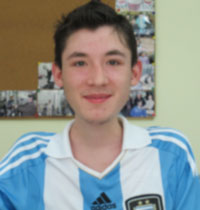Matias - Duchenne progressive muscular dystrophy (Argentina) Posted on July 15, 2013
Name: Matias Nicolas Ceballos Salomoni 
Sex: Male
Country: Argentina
Age: 14 years
Diagnosis: Duchenne progressive muscular dystrophy
Admission Date: 2013-05-16
Days Admitted to the Hospital: 29
Before treatment:
The patient would often fall down during PE class. He went to a local hospital and the doctor found there was obvious weakness in her lower body. He underwent a series of examinations and muscle biopsy as well. He was diagnosed with Duchenne progressive muscular dystrophy. The patient then received rehabilitation training. The disease progressed gradually, causing the weakness in both lower limbs to be aggravated. There was also muscle atrophy and damaged pelvic girdle. He began falling down more frequently and started using a wheel chair. At age 9, he was no longer able to walk. He suffered from weakness and muscle atrophy of both upper limbs when he was 11-12 years old. He had difficulty with everyday activities. He suffered from weakness in the neck and had poor control of his head. In addition, he suffered from fatigue.
At present, the patient is unable to take care of himself. There is weakness in the shoulder girdle, pelvic girdle, both upper limbs and both lower limbs' skeletal muscle. This is accompanied by severe muscle atrophy. He suffered from heart palpitation after exercising. There was no obvious difficulty breathing or other discomfort. There was no cough while eating, but the mealtime was enlarged.
Admission PE:
Bp: 102/66mmHg; Hr: 96/min, temperature: 36.0 degrees. Weight: 27Kg. The skin and mucosa were normal, with no yellow stains or petechia. Through auscultation, the respiratory sounds in both lungs were clear, with no rales. His heartbeat was strong, the cardiac rate was normal, with no obvious murmuring. The abdomen was smooth and soft. There was no pressing pain or rebound tenderness. We did not touch the liver or spleen under the ribs. There was severe muscle atrophy of the shoulder girdle, pelvic girdle, both upper limbs' skeletal muscle and both lower limbs' skeletal muscle. There was mild contracture of bilateral knees, ankle joints and tendo calcaneus. Strephenopodia of both feet, and both feet were deteriorating.
Nervous System Examination:
Matias Nicolas Ceballos Salomoni was alert, and he was in good spirits. His speech was clear. His memory, ability to calculate, and orientation were all normal. Both pupils were equal in size and round, with a diameter of 3.0mms. Both eyeballs could move freely and flexibly and the pupils were sensitive to light stimulus. The forehead wrinkle pattern was symmetrical. He had fully capable of closing his eyes. The bilateral nasolabial sulcus was equal in depth. The tongue was centered in the oral cavity and the teeth were shown without deflection. There was no air leakage when he pulsated his cheeks. He could raise the soft palate symmetrically and strongly. The muscle strength in the neck was weak. The muscle strength at the closest end of both upper limbs' was level 1 and the farthest end was level 3-. The power to hold of both hands was level 3. The muscle strength of both lower limbs' closest end was level 1 and the farthest end was level 2. The muscle tone of the four limbs was low. The tendon reflex of the four limbs was not elicited. The abdominal reflexes were normal. The bilateral palm jaws reflex was negative, and the bilateral Hoffmann sign and Rossilimo sign were both negative. The Bilateral Babinski sign was negative. The deep and shallow sensation and fine sensation were normal through loose measures. He had difficulty with the finger-to-nose test, digital opposition test and the rapid rotation test. He had difficulty with the heel-knee-shin test. There were no signs of meningeal irritation.
Treatment:
We initially gave Matias Nicolas Ceballos Salomoni a complete examination. He was diagnosed with Duchenne progressive muscular dystrophy. He received treatment to repair his muscle and regenerate muscle fibers. He received treatment to improve his blood circulation, in order to increase the blood supply to the damaged neurons. He also received treatment to nourish the nerves, nourish muscular tissue, which strengthens nutrition and regulates the immune ability.
Post-treatment:
The patient has better muscular movement function. The muscle strength of the neck and four limbs has improved. The muscle strength of both upper limbs' closest end is level 2 and the farthest end is level 3+. The muscle strength of both lower limbs' closest end is level 3- and the farthest end is level 2+. His muscular endurance has increased. The amount time he is able to be active has been extended. The muscle volume of both lower limbs' closest end has increased.
(Download the Windows Media Player Firefox Plugin if you are using Firefox browser.
To know more,Please read Using the Windows Media Player plugin with Firefox.)
